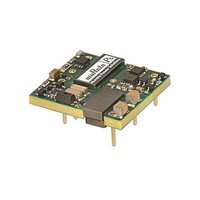UEI-15/3.3-Q12N-C Murata Power Solutions Inc, UEI-15/3.3-Q12N-C Datasheet - Page 8

UEI-15/3.3-Q12N-C
Manufacturer Part Number
UEI-15/3.3-Q12N-C
Description
DC/DC TH Q12-15V UEI
Manufacturer
Murata Power Solutions Inc
Datasheet
1.UHE-122500-Q12-C.pdf
(13 pages)
Specifications of UEI-15/3.3-Q12N-C
Lead Free Status / Rohs Status
Lead free / RoHS Compliant
current, thereby maintaining a somewhat constant power output. This is com-
monly referred to as power limiting.
below the rated tolerance. See the Performance/Functional Specifi cations. Note
particularly that the output current may briefl y rise above its rated value. This
enhances reliability and continued operation of your application. If the output
current is too high, the converter will enter the short circuit condition.
Output Short Circuit Condition
When a converter is in current-limit mode, the output voltage will drop as the
output current demand increases. If the output voltage drops too low, the mag-
netically coupled voltage used to develop primary side voltages will also drop,
thereby shutting down the PWM controller. Following a time-out period, the
PWM will restart, causing the output voltage to begin ramping up to its appro-
priate value. If the short-circuit condition persists, another shutdown cycle will
initiate. This on/off cycling is called “hiccup mode”. The hiccup cycling reduces
the average output current, thereby preventing excessive internal tempera-
tures. A short circuit can be tolerated indefi nitely.
Remote Sense Input
Sense inputs compensate for output voltage inaccuracy delivered at the load.
This is done by correcting voltage drops along the output wiring such as mod-
erate IR drops and the current carrying capacity of PC board etch. Sense inputs
also improve the stability of the converter and load system by optimizing the
control loop phase margin.
low value resistors to their respective polarities so that the converter can
operate without external connection to the Sense. Nevertheless, if the Sense
function is not used for remote regulation, the user should connect +Sense to
+V
coupled to the output lines and therefore are in the feedback control loop to
regulate and stabilize the output. As such, they are not low impedance inputs
and must be treated with care in PC board layouts. Sense lines on the PCB
should run adjacent to DC signals, preferably Ground. In cables and discrete
wiring, use twisted pair, shielded tubing or similar techniques.
Current limiting inception is defi ned as the point at which full power falls
Note: The Sense input and power Vout lines are internally connected through
OUT
The remote Sense lines carry very little current. They are also capacitively
Please observe Sense inputs tolerance to avoid improper operation:
and –Sense to –V
[V
4
2
1
OUT
(+) –V
−
ON/OFF
CONTROL
+INPUT
INPUT
Figure 4 – Remote Sense Circuit Confi guration
OUT
OUT
(-)] – [ Sense(+) – Sense(-)] ≤ 10% of V
at the converter pins.
+OUTPUT
-OUTPUT
+SENSE
−
SENSE
TRIM
6
5
9
8
7
Contact and PCB resistance
Contact and PCB resistance
Sense Current
Sense Return
I
losses due to IR drops
OUT
losses due to IR drops
I
OUT
Return
LOAD
www.murata-ps.com
OUT
Sense pin. Therefore excessive voltage differences between Vout and Sense
together with trim adjustment of the output can cause the overvoltage protec-
tion circuit to activate and shut down the output.
output current and the highest output voltage. Therefore the designer must insure:
Trimming the Output Voltage
The Trim input to the converter allows the user to adjust the output voltage over
the rated trim range (please refer to the Specifi cations). In the trim equations and
circuit diagrams that follow, trim adjustments use either a trimpot or a single
fi xed resistor connected between the Trim input and either the +Sense or –Sense
terminals. (On some converters, an external user-supplied precision DC voltage
may also be used for trimming). Trimming resistors should have a low tempera-
ture coeffi cient (±100 ppm/deg.C or less) and be mounted close to the converter.
Keep leads short. If the trim function is not used, leave the trim unconnected.
With no trim, the converter will exhibit its specifi ed output voltage accuracy.
maximum output voltage OR the maximum output power when setting the trim.
Be particularly careful with a trimpot. If the output voltage is excessive, the
Output overvoltage protection is monitored at the output voltage pin, not the
Power derating of the converter is based on the combination of maximum
There are two CAUTION’s to be aware for the Trim input:
CAUTION: To avoid unplanned power down cycles, do not exceed EITHER the
Figure 6 – Trim adjustments to decrease Output Voltage using a Fixed Resistor
50-60W Isolated Wide-Range DC/DC Converters
2
4
1
2
4
1
−
ON/OFF
CONTROL
+INPUT
(V
−
ON/OFF
CONTROL
+INPUT
INPUT
INPUT
OUT
at pins) x (I
Figure 5 – Trim adjustments using a trimpot
04 Nov 2010
+OUTPUT
−
+OUTPUT
−
OUTPUT
+SENSE
+SENSE
−
OUTPUT
−
OUT
SENSE
SENSE
TRIM
TRIM
) ≤ (Max. rated output power)
MDC_UEI Series 50-60W.B33 Page 8 of 13
6
5
9
8
7
6
5
9
8
7
R
email: sales@murata-ps.com
TRIM DOWN
UEI Series
TURNS
7
5-22
LOAD
LOAD
























